 We get a lot of enquiries from people who have been persuaded by insurers to deal with their personal injury claims directly with them. It’s a common problem in the claiming industry, and it’s known as Third Party Capture. Basically, the insurers of the party at fault will contact the innocent victims direct and offer to deal with the personal injury claim without solicitors.
We get a lot of enquiries from people who have been persuaded by insurers to deal with their personal injury claims directly with them. It’s a common problem in the claiming industry, and it’s known as Third Party Capture. Basically, the insurers of the party at fault will contact the innocent victims direct and offer to deal with the personal injury claim without solicitors.
They will tell you that it’s quicker, easier, and you’re cutting out the middleman; and by claiming directly with them, they will give you a little more money as they will save themselves a fortune on not paying legal fees.
But what you have to ask yourself is, in the grand scheme of things – why would they do this?
It’s literally all about saving money. I doubt very much that they will offer you an extra £1,500, which is generally what the solicitors’ legal fees will equate to. In fact, it’s unheard of as far as I’m aware. But the main thing you have to realise, which is something you might not have considered, is the fact that you have nobody fighting your corner for the case. In fact, you entirely at the mercy of the insurers who are liable to compensate you.
Read More

 Industrial deafness is a form of industrial disease. If you are suffering from industrial deafness then you may be entitled to make a
Industrial deafness is a form of industrial disease. If you are suffering from industrial deafness then you may be entitled to make a  Health and safety is of course vitally important. But it is also incredibly frustrating at times as well. We can all see that health and safety rules are necessary, such as in the workplace or at certain attractions (such as theme parks etc).
Health and safety is of course vitally important. But it is also incredibly frustrating at times as well. We can all see that health and safety rules are necessary, such as in the workplace or at certain attractions (such as theme parks etc).  The Government have recently advised that in April 2013 routine health and safety inspections are no longer to continue on business premises that are considered to be of low risks. This new suggestion is part of the Government’s plans to remove or change more than 3,000 of the current health and safety regulations.
The Government have recently advised that in April 2013 routine health and safety inspections are no longer to continue on business premises that are considered to be of low risks. This new suggestion is part of the Government’s plans to remove or change more than 3,000 of the current health and safety regulations. Slipping on a wet floor may seem to some people like a sketch from a slap-stick comedy film but for those people who have ever had the misfortune to be the victim of a fall on a wet floor, it is not a source of humour. In fact the instances where accidents of this type happen can be the cause of a lot more than embarrassment or bruised ego and can cause serious injuries.
Slipping on a wet floor may seem to some people like a sketch from a slap-stick comedy film but for those people who have ever had the misfortune to be the victim of a fall on a wet floor, it is not a source of humour. In fact the instances where accidents of this type happen can be the cause of a lot more than embarrassment or bruised ego and can cause serious injuries. To be honest, the thought of a chemical burn is pretty frightening. If you have ever seen the film Fight Club, you might know what I mean. But when it happens to someone, and you are badly injured as a result, what can you do?
To be honest, the thought of a chemical burn is pretty frightening. If you have ever seen the film Fight Club, you might know what I mean. But when it happens to someone, and you are badly injured as a result, what can you do? We get a lot of enquiries from people who have been persuaded by insurers to deal with their
We get a lot of enquiries from people who have been persuaded by insurers to deal with their  We all reply upon equipment to do our jobs; some more than others, depending on the type of work you do. One thing I can confidently say from personal perspective is that I personally cannot stand most equipment! We rely upon it to do our jobs, and then it never works right and always breaks! Yes computers – I’m looking at you!
We all reply upon equipment to do our jobs; some more than others, depending on the type of work you do. One thing I can confidently say from personal perspective is that I personally cannot stand most equipment! We rely upon it to do our jobs, and then it never works right and always breaks! Yes computers – I’m looking at you! Cosmetic surgery is becoming increasingly popular with youth today due to the ‘need’ to look good and therefore there has been a noticeable rise of claims resulting from
Cosmetic surgery is becoming increasingly popular with youth today due to the ‘need’ to look good and therefore there has been a noticeable rise of claims resulting from  Often at the outset of a claim people will want to know how much
Often at the outset of a claim people will want to know how much 









